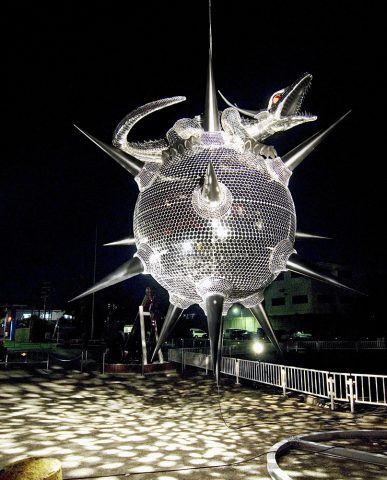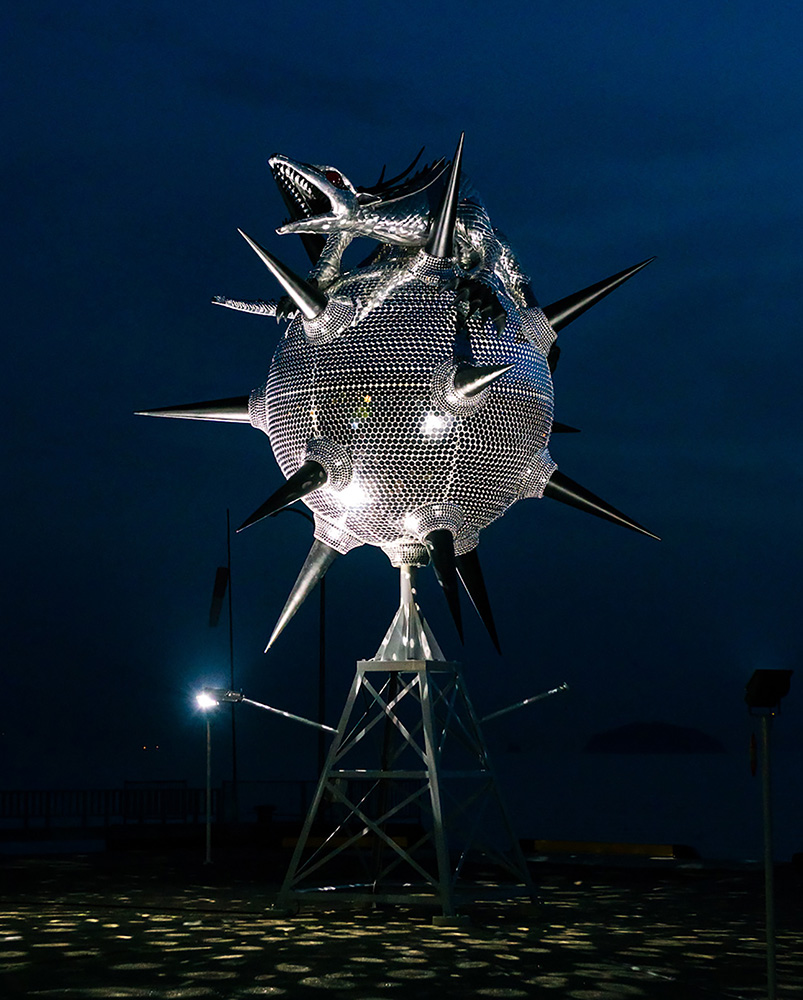(1/2) THE STAR ANGER [2012-2013]
THE STAR ANGER
Light of Anger Refrected by Mirrors

NAMURA ART MEETING ’04–’34 is a long term art project, planned to be held for 30 years, from 2004 to 2034, based in The former Namura Shipyard site (Suminoe-ku, Osaka Prefecture, Japan), owned by Chishima Real Estate Co.,Ltd. The purpose of this project is to change the place through various events.
The exective committee asked Kenji Yanobe to make a work of mirrorball for NAMURA ART MEETING ’04–’34 vol. 04 (2012). Yanobe had made a work of mirror ball before for NAMURA ART MEETING ’04–’34 vol. 00 (2004). In the course of this project, NAMURA ART MEETING ’04–’34 vol. 04 was the first event after the Great East Japan Earthquake and the project intended to return to its origin. Yanobe proceeded to design and make THE STAR ANGER, the work of huge mirror ball with a diameter of 5m, which materially exceeded the size the committee had asked for.
In contrast with Sun Child (2011-2012), which has “overtly positive” themes, the theme of THE STAR ANGER was “anger”, which appeared to have a negative intent. At the same time of making this work, demonstrations against restarting of Ohi Nuclear Power Plant were held throughout Japan. People reacted to the messages spread by SNS, gathered in front of Prime Minister’s Official Residence for protest. At most, tens of thousands people gathered for anti-nuke demonstrations.
“Anger” is one of Yanobe’s enduring themes. In 2005, he made Giant Torayan at 21st Century Museum of Contemporary Art, Kanazawa. Giant Torayan is a work of huge robot, obedient only to commands from children and it spit fire from its mouth with the energy of “anger”. Children are minor beings in the society which adults have made, and at the same time, they are the hope for future. In Giant Torayan, Yanobe expressed the energy of “anger” which children and socially vulnerable have, and made it a symbol of energy to crash through the existing power structure.
Many parents and children joined the anti-nuke demonstrations and citizen’s power of “anger” was a positive one that would make changes on the existing nuclear energy policy. Inspired by citizen’s power of “anger”, Yanobe designed a mirror ball spinning around and emitting light in all directions, and put a sculpture of screaming dragon on the mirror ball.
In order to make a huge mirror ball, he jointed two huge hemispheres and pasted round mirrors on the surface. Horns are sticking out from the mirror ball in a radial pattern. The mirror ball resembles with Ultra–Black Sun (2009) and the shape metaphorically indicates nuclear power.
The dragon howling with anger was modeled with styrofoam and made of alminum plates fastened with rivets and its eyes were made of red glass balls. He used these techniques when he made Lucky Dragon (2009) and he applied the technique of making crystal eyes in buddhist statues in Kamakura Period.
Many of Yanobe’s works have mechanism of moving with own motive power and some of them emit fire and water. However, in the case of THE STAR ANGER, the pedestal itself is a sphere and rotates with the sculpture of dragon and it neither moves with its motive power nor emits fire. The mirror ball reflects light and rotates with external motive power and reflected light makes countless patterns of light on the surface of ground, walls and ceilings.
THE STAR ANGER shines at night like the moon reflecting sunlight and it works like a planetarium. In terms of these characteristics, THE STAR ANGER and Sun Child, which shines in itself, are contrastive in their characters. THE STAR ANGER were installed in front of the former site of Namura dockyard located on the bank of Kizu River and shed light on nearby buildings like a lighthouse and shone brightly against the backgound of industrial area on the opposite bank.
